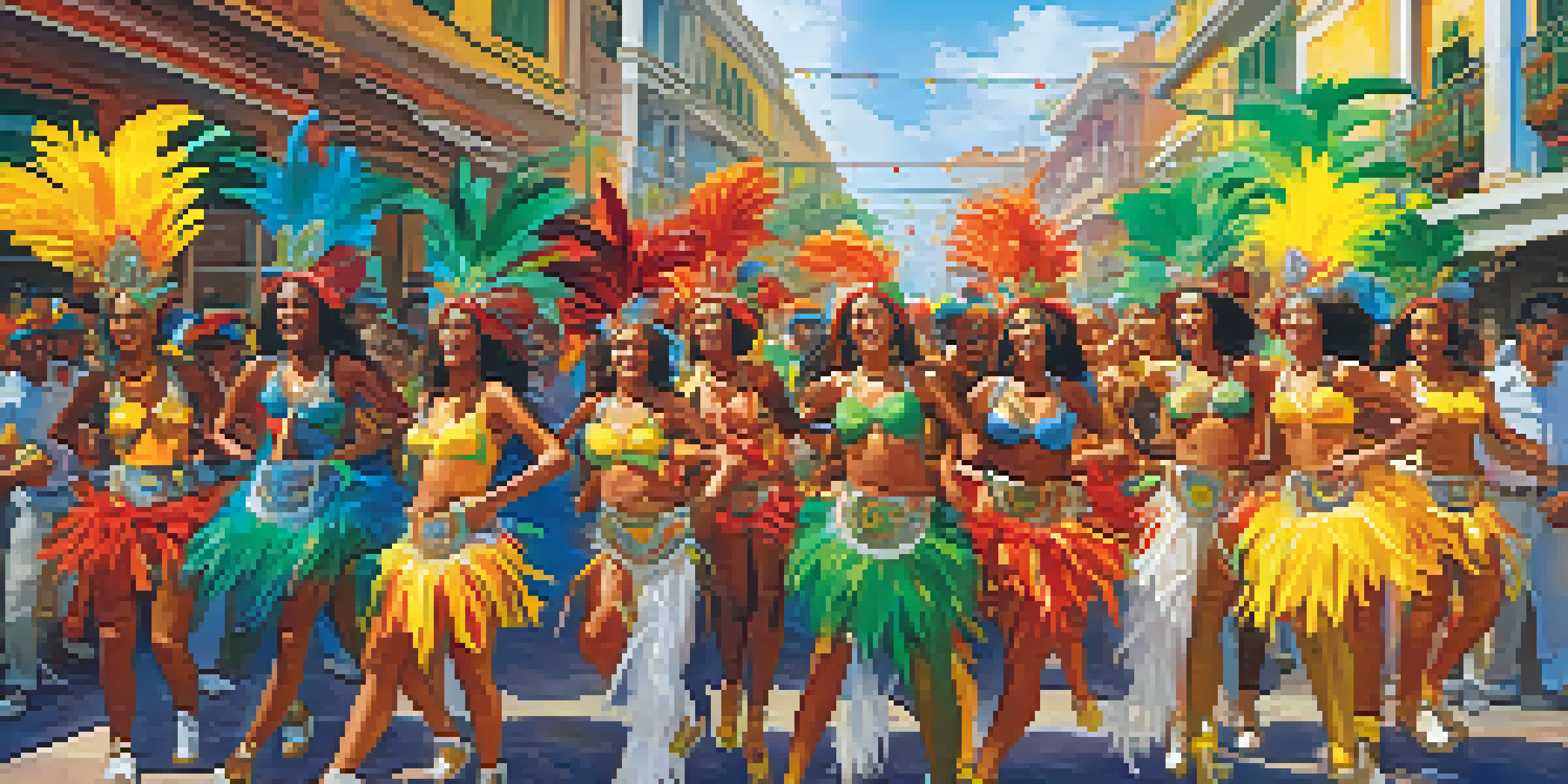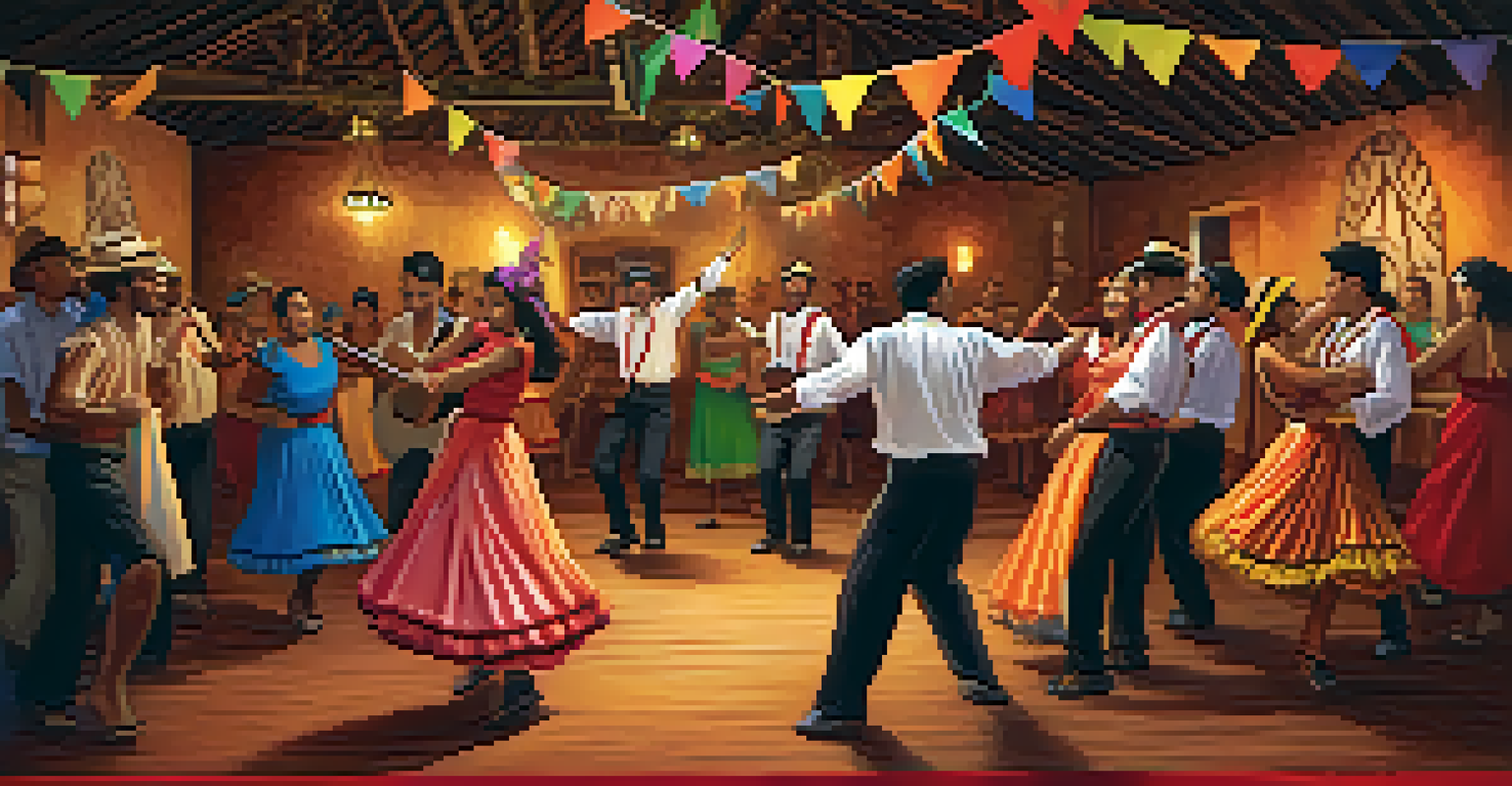Brazilian Music Genres: A Soundtrack of National Identity

The Rich Tapestry of Brazilian Music
Brazilian music is a vibrant blend of styles that reflects the country's diverse cultural influences. From Indigenous rhythms to African beats and European melodies, each genre tells a unique story. This musical tapestry not only entertains but also serves as a historical record of Brazil's evolution.
Music is the shorthand of emotion.
For instance, the fusion of these elements can be heard in Samba, a genre that originated in the Afro-Brazilian communities of Rio de Janeiro. Samba's lively rhythms and dance, often seen during Carnival, embody the spirit of celebration and resilience in Brazilian culture.
Each genre, whether it's Bossa Nova, Forró, or MPB (Música Popular Brasileira), contributes to a collective identity that resonates with the heart and soul of the nation. It's a testament to how music can capture and convey the essence of a people's journey.
Samba: The Soul of Brazil
Samba is perhaps the most iconic genre associated with Brazil, known for its infectious rhythms and vibrant dance styles. Emerging from the Afro-Brazilian communities in the early 20th century, Samba has evolved into a symbol of Brazilian culture, especially during Carnival festivities.

The music's fast-paced beats and syncopated rhythms encourage people to dance, bringing communities together in joyous celebration. Songs often tell stories of love, struggle, and daily life, making them relatable to many Brazilians.
Diversity Shapes Brazilian Music
Brazilian music is a rich blend of Indigenous, African, and European influences, each genre reflecting the country's cultural tapestry.
Samba's significance goes beyond mere entertainment; it represents a cultural movement that celebrates identity and unity among diverse populations. The genre has also inspired countless artists worldwide, proving that the spirit of Samba transcends borders.
Bossa Nova: The Sound of Cool Brazil
Bossa Nova emerged in the 1950s as a smooth blend of Samba and jazz, characterized by its laid-back rhythms and intricate guitar work. This genre encapsulates the essence of Brazil's urban culture, particularly in cities like Rio de Janeiro, where it originated.
Where words fail, music speaks.
Artists like João Gilberto and Tom Jobim became global ambassadors of Bossa Nova, introducing the world to its soothing melodies and poetic lyrics. Songs like 'Garota de Ipanema' quickly became classics, reflecting themes of love and longing.
Bossa Nova's influence extends far beyond Brazil, impacting musicians globally and embedding itself into the fabric of popular music. Its cool, sophisticated vibe makes it a favorite in cafes and lounges, evoking a sense of nostalgia for simpler times.
Forró: A Dance of Togetherness
Forró is a lively genre that originated in the Northeast of Brazil, combining elements of European folk music with local rhythms. Traditionally played at festivals and gatherings, Forró is more than just music; it's a social event that brings people together to dance.
The infectious beats encourage couples to move in sync, showcasing intricate footwork and passionate expressions. Instruments like the accordion, zabumba (a type of drum), and triangle create a distinctive sound that invites everyone to join in the fun.
Samba: A Cultural Symbol
Samba stands out as an iconic genre that embodies Brazilian culture, particularly during Carnival, highlighting themes of community and celebration.
Forró's popularity has surged in recent years, drawing younger generations to embrace their cultural heritage. It's a beautiful reminder of how music can foster community and connection, regardless of age or background.
MPB: The Evolution of Brazilian Popular Music
Música Popular Brasileira, or MPB, emerged in the 1960s as a genre that blended traditional Brazilian music with international influences. It reflects Brazil's social and political landscape, often addressing contemporary issues through lyrics that resonate with the public.
Artists like Caetano Veloso and Gilberto Gil became pivotal in this movement, using their music as a form of protest and artistic expression. MPB's rich melodies and poetic lyrics have captivated audiences both in Brazil and abroad, establishing a new wave of Brazilian music.
Today, MPB continues to evolve, incorporating elements from various genres while maintaining its core identity. It serves as a bridge between generations, connecting the past with the present in a vibrant musical dialogue.
Axé: The Pulse of Bahia
Axé music originated in the state of Bahia during the 1980s, combining Afro-Brazilian rhythms with elements of pop and reggae. This genre is synonymous with the vibrant Carnaval celebrations in Salvador, where its upbeat tempos get everyone on their feet.
Artists like Ivete Sangalo and Chiclete com Banana have popularized Axé, making it a staple of Brazilian festive culture. The music's catchy hooks and lively beats create an atmosphere of joy and unity, inviting people to dance and celebrate together.
Global Impact of Brazilian Sounds
Brazilian music has influenced artists worldwide, showcasing its vibrant rhythms and fostering cultural exchange through diverse genres.
Axé's infectious energy embodies the spirit of Bahia, showcasing the region's rich cultural heritage. As a genre that promotes togetherness, Axé transcends social and economic barriers, making it a beloved soundtrack for many Brazilians.
The Impact of Brazilian Music on Global Culture
Brazilian music has made significant waves on the global stage, influencing countless artists and genres worldwide. From the smooth sounds of Bossa Nova to the energetic beats of Samba, Brazilian rhythms have infused international music with their unique flair.
Musicians like Sergio Mendes and Astrud Gilberto have played key roles in introducing Brazilian sounds to mainstream audiences. Their collaborations with international artists have helped bridge cultural gaps and showcase the richness of Brazil's musical heritage.

Today, genres like Samba, Bossa Nova, and MPB continue to inspire musicians across the globe, proving that music is a universal language that connects us all. The impact of Brazilian music underscores the importance of cultural exchange and the celebration of diversity in the arts.
Conclusion: Celebrating Brazil's Musical Heritage
Brazilian music is more than just a collection of genres; it's a powerful expression of national identity and cultural diversity. Each genre tells a story, reflecting the struggles, joys, and complexities of Brazilian life.
As we explore these musical styles, we gain insight into the heart of Brazil and the people who call it home. Through music, Brazilians celebrate their heritage, foster community, and share their culture with the world.
In recognizing the importance of Brazilian music, we not only appreciate its artistic value but also honor the rich tapestry of experiences that shape a nation. Let's continue to celebrate and share this vibrant soundtrack of Brazil, ensuring its legacy lives on.